
Rhaphigaster nebulosa, common name mottled shieldbug, is a species of stink bug in the family Pentatomidae.

Elasmostethus interstinctus, the birch shield bug, is species of shield bug in the Acanthosomatidae family. Shield bugs are often called "stink bugs" because they excrete a foul smelling liquid that is used to deter predators.
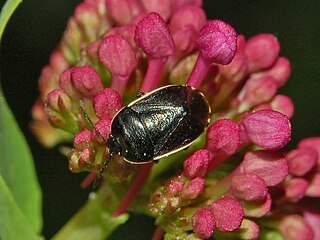
Canthophorus dubius is a species of burrowing bugs or negro bugs belonging to the family Cydnidae, subfamily Sehirinae.
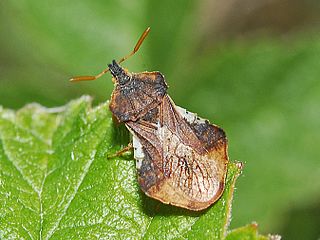
Phymata crassipes is a species of assassin and thread-legged bugs belonging to the family Reduviidae, subfamily Phymatinae.
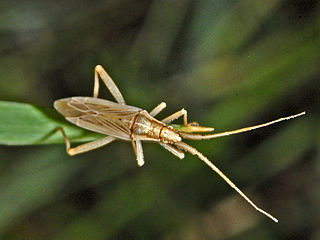
Stenodema holsata is a species of bug from the family Miridae.

Deraeocoris ruberis a species of bug in the Miridae family.
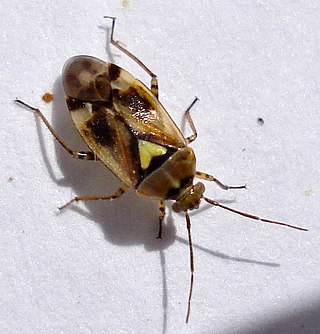
Orthops basalis is a species of plant bugs belonging to the family Miridae, subfamily Mirinae that can be found everywhere in Europe except for Azores, Bosnia and Herzegovina Faroe Islands, Iceland and Cyprus. then east across the Palearctic to Central Asia and Siberia.

Orthops campestris is a species of plant bugs belonging to the family Miridae, subfamily Mirinae, that can be found everywhere in Europe except for Azores, Faroe Islands, Iceland and African islands such as Canary Islands and Cyprus. and across the Palearctic to Central Asia and Siberia.

Gonocerus acuteangulatus is a herbivorous species of true bug in the family Coreidae. It is commonly known as the box bug in the UK as it once only occurred in Box Hill in Surrey where it fed on box trees.

Piezodorus lituratus, the gorse shield bug, is a species of Pentatomidae, a family of shield bugs.

Peribalus strictus, common name Vernal Shieldbug, is a species of shield bugs in the family Pentatomidae.

Stictopleurus punctatonervosus is a species of scentless plant bugs belonging to the family Rhopalidae, subfamily Rhopalinae.

Sehirus luctuosus, the Forget-me-not Bug, is a burrowing shieldbug belonging to the family Cydnidae. It is found from Europe to Central Asia.In Central Europe it is widespread and not uncommon. They are found in the Alps on sunny slopes up to almost 2000 meters above sea level.
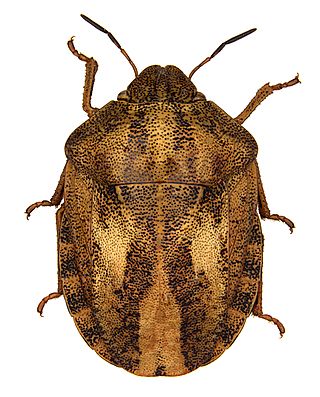
Eurygaster testudinaria is a Palearctic shieldbug. It occurs in Europe from the Northern Mediterranean to southern Scandinavia, and East through Central Asia to northern China and Japan.

Alydus calcaratus is a bug species with a Holarctic distribution ranging from the British Isles almost all over Europe to eastern Siberia and China. Moreover, the species also in northern North America from Alaska and Québec across the United States to Wyoming. It is the only species in the family in northern Central Europe outside of the Alps.

Macrosaldula scotica is a predatory species of true bug, from the family Saldidae in the order Hemiptera from the western Palearctic.
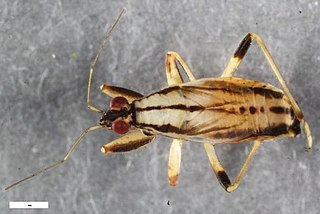
Himacerus boops is a species of damsel bug in the family Nabidae. It is found from South Scandinavia and the South of the British Isles over Western and Central Europe and East across the Palearctic to Siberia and in the Caspian region. They are not present in most parts of the Mediterranean.
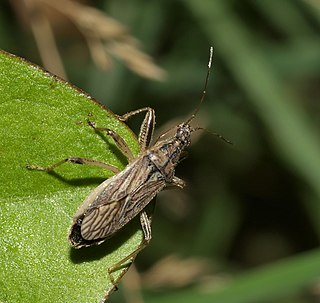
Himacerus major is a species damsel bug in the family Nabidae. It is found in the Holarctic. The range is from South Scandinavia and the South of the British Isles over West Europe including the Western Mediterranean, Central Europe and Eastern Europe and in the Caucasus. It is also found in North America. Himacerus major occurs in many different habitats with grass, regardless of the level of humidity. The species occurs on very dry dune habitats, and nutrient-poor grasslands,as well as wet shores of waters without woody vegetation and salt places inland. The species occurs in very large numbers near the coast of the Northern Baltic Sea. It is absent from woodland.

Drymus brunneus is a species of dirt-colored seed bug in the family Rhyparochromidae found in the Palearctic. In the West Palearctic it is lacking only in the far north of Northern and Eastern Europe. In the East, the species ranges to the Caucasus and Siberia.

Plagiognathus arbustorum is a species of insects in the family Miridae, the plant bugs.






















